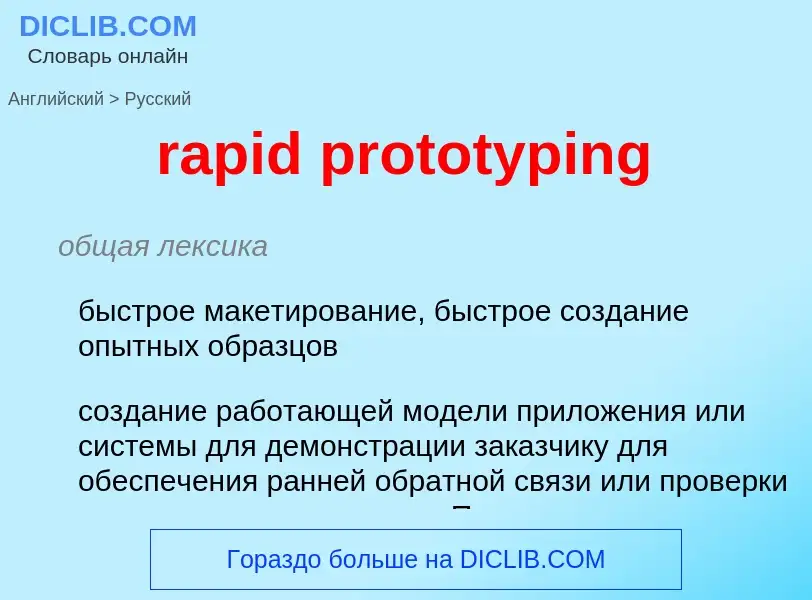Traduzione e analisi delle parole tramite l'intelligenza artificiale ChatGPT
In questa pagina puoi ottenere un'analisi dettagliata di una parola o frase, prodotta utilizzando la migliore tecnologia di intelligenza artificiale fino ad oggi:
- come viene usata la parola
- frequenza di utilizzo
- è usato più spesso nel discorso orale o scritto
- opzioni di traduzione delle parole
- esempi di utilizzo (varie frasi con traduzione)
- etimologia
rapid prototyping - traduzione in russo
общая лексика
быстрое макетирование, быстрое создание опытных образцов
создание работающей модели приложения или системы для демонстрации заказчику для обеспечения ранней обратной связи или проверки возможности реализации. Прототип позже уточняется для получения конечного продукта
['ræpid'siti]
география
г. Рапид-Сити
нефтегазовая промышленность
быстродействующий песочный фильтр
Definizione
Wikipedia

Rapid prototyping is a group of techniques used to quickly fabricate a scale model of a physical part or assembly using three-dimensional computer aided design (CAD) data. Construction of the part or assembly is usually done using 3D printing or "additive layer manufacturing" technology.
The first methods for rapid prototyping became available in mid 1987 and were used to produce models and prototype parts. Today, they are used for a wide range of applications and are used to manufacture production-quality parts in relatively small numbers if desired without the typical unfavorable short-run economics. This economy has encouraged online service bureaus. Historical surveys of RP technology start with discussions of simulacra production techniques used by 19th-century sculptors. Some modern sculptors use the progeny technology to produce exhibitions and various objects. The ability to reproduce designs from a dataset has given rise to issues of rights, as it is now possible to interpolate volumetric data from 2D images.
As with CNC subtractive methods, the computer-aided-design – computer-aided manufacturing CAD -CAM workflow in the traditional rapid prototyping process starts with the creation of geometric data, either as a 3D solid using a CAD workstation, or 2D slices using a scanning device. For rapid prototyping this data must represent a valid geometric model; namely, one whose boundary surfaces enclose a finite volume, contain no holes exposing the interior, and do not fold back on themselves. In other words, the object must have an "inside". The model is valid if for each point in 3D space the computer can determine uniquely whether that point lies inside, on, or outside the boundary surface of the model. CAD post-processors will approximate the application vendors' internal CAD geometric forms (e.g., B-splines) with a simplified mathematical form, which in turn is expressed in a specified data format which is a common feature in additive manufacturing: STL file format, a de facto standard for transferring solid geometric models to SFF machines.
To obtain the necessary motion control trajectories to drive the actual SFF, rapid prototyping, 3D printing or additive manufacturing mechanism, the prepared geometric model is typically sliced into layers, and the slices are scanned into lines (producing a "2D drawing" used to generate trajectory as in CNC's toolpath), mimicking in reverse the layer-to-layer physical building process.

![A rapid prototyping machine using [[selective laser sintering]] (SLS) A rapid prototyping machine using [[selective laser sintering]] (SLS)](https://commons.wikimedia.org/wiki/Special:FilePath/3dprinter.jpg?width=200)
.jpg?width=200)

![National Guard]] officer candidates take part in a tactical road march through a west Rapid City neighborhood. National Guard]] officer candidates take part in a tactical road march through a west Rapid City neighborhood.](https://commons.wikimedia.org/wiki/Special:FilePath/Officer candidates step off to final training phase 110716-A-DI382-012.jpg?width=200)

![[[Rapid City Public Library]] [[Rapid City Public Library]]](https://commons.wikimedia.org/wiki/Special:FilePath/RCPL.jpg?width=200)
![View of the city from [[Dinosaur Park]] View of the city from [[Dinosaur Park]]](https://commons.wikimedia.org/wiki/Special:FilePath/Rapid City, South Dakota seen from Dinosaur Park.jpg?width=200)
![View of southern Rapid City from the east after a rainstorm, including a view of [[Black Elk Peak]] and the [[Black Hills]] View of southern Rapid City from the east after a rainstorm, including a view of [[Black Elk Peak]] and the [[Black Hills]]](https://commons.wikimedia.org/wiki/Special:FilePath/Rapid City from Rapid Valley 090604.jpg?width=200)
![Air Force officer]], [[test pilot]], and [[NASA]] [[astronaut]] and commander of [[Apollo 10]] Air Force officer]], [[test pilot]], and [[NASA]] [[astronaut]] and commander of [[Apollo 10]]](https://commons.wikimedia.org/wiki/Special:FilePath/Thomas Stafford.jpg?width=200)
![Trump Presidential Campaign Director]],South Dakota state senator. Trump Presidential Campaign Director]],South Dakota state senator.](https://commons.wikimedia.org/wiki/Special:FilePath/Neal_Tapio_in_Watertown,_South_Dakota.jpg?width=200)
![U.S. Representative]] from South Dakota, First Arab-American U.S. SenatorandAuthor, [[Indian Child Welfare Act]]. U.S. Representative]] from South Dakota, First Arab-American U.S. SenatorandAuthor, [[Indian Child Welfare Act]].](https://commons.wikimedia.org/wiki/Special:FilePath/James Abourezk.jpg?width=200)
![[[Adam Vinatieri]],NFL Kicker and four-time Super Bowl Champion [[Adam Vinatieri]],NFL Kicker and four-time Super Bowl Champion](https://commons.wikimedia.org/wiki/Special:FilePath/Vinatieri, Adam (USAF).jpg?width=200)
![[[Lawrence Lessig]],[[Harvard Law School]] professor, co-founder of the [[Creative Commons]] [[Lawrence Lessig]],[[Harvard Law School]] professor, co-founder of the [[Creative Commons]]](https://commons.wikimedia.org/wiki/Special:FilePath/Lawrence Lessig May 2017.jpg?width=200)
![Emily M. Bishop]], superintendent of Rapid City public schools, first woman thus honored in the [[Dakota Territory]] Emily M. Bishop]], superintendent of Rapid City public schools, first woman thus honored in the [[Dakota Territory]]](https://commons.wikimedia.org/wiki/Special:FilePath/EMILY MULKIN BISHOP.jpg?width=200)

